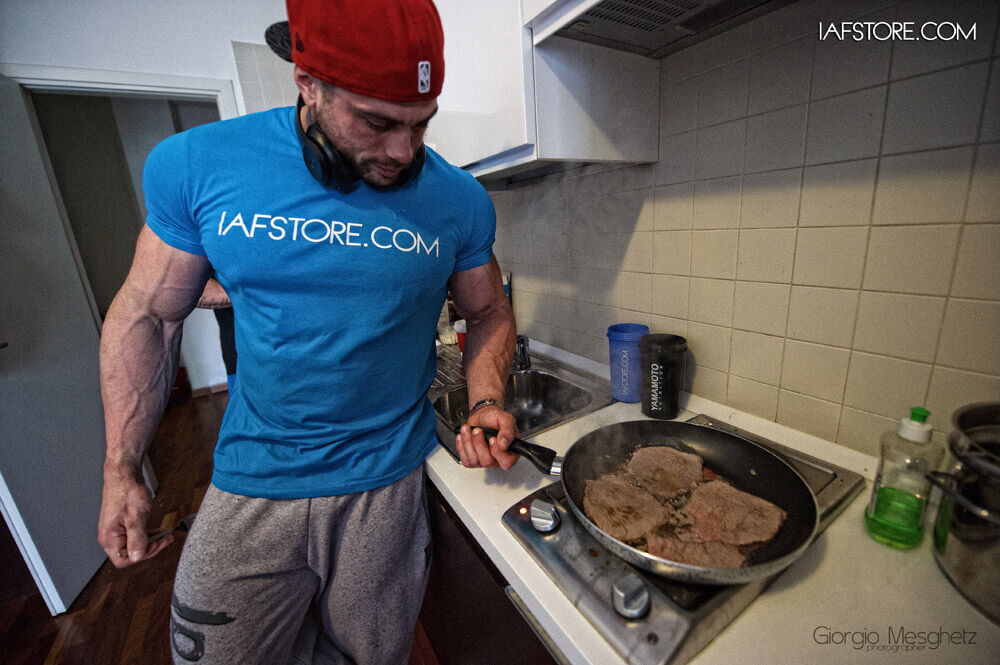This article will discuss the ABCDE diet (Anabolic Burst Cycling Of Diet and Exercise) designed by Torbjon Akerfeldt, endocrinologist and bodybuilders, during the 1990s.
The diet of our ancestors
Akerfeldt's hypothesis is based on the fact that our genetics, and therefore our physiology, have not changed significantly compared to those of our earliest ancestors, who were hunters and/or gatherers.
But what does this mean?
Our ancestors had a diet characterised by alternating periods of dietary restriction with other periods of ''bingeing'', i.e. repeatedly switching between a low-calorie and high-calorie diet. For example, when they had successful hunting they could eat meat for several weeks, and in so doing have a high caloric intake; conversely, when the food had run out and they could not hunt, they had to effectively survive on a low-calorie diet based on vegetables until the next hunt.
In this way their metabolism (and ours) became extremely flexible, to adapt to sudden changes in the calories available.

Put on lean mass and lose fat
As it is practically impossible to gain lean mass and lose body fat at the same time according to this regimen, you must first concentrate on one and then the other, living in caloric intake cycles, like our ancestors: alternately highly anabolic and highly catabolic phases.
To this periodisation, the following are then added: training, rationing of macronutrients, with different supplementation levels depending on your current metabolic state.
During the high-calorie phase it will be possible to detect an increase in IGF-1, testosterone and insulin levels, the hormones at the base of the muscle building, but there is one small problem.... these start to reduce, or level off, within 2 weeks.
After these two weeks, to raise them back up through supercompensation, you will switch suddenly to the low-calorie phase (from 5000 to 2000 kcal from one day to another, for instance), making sure to lose the excess fat accumulated during the first part of the ABCDE cycle (as mentioned earlier, it is impossible to increase contractile tissue and not simultaneously accumulate too much fat, especially with a caloric intake above our TDEE).
Then, in approximately another 2 weeks, our body starts to get accustomed, and begins saving energy as much as possible, to preserve its homeostasis.
In conclusion, to put it simply, Torbjon Akerfeldt identified two phases in the ABCDE diet, alternating every two weeks: one low-calorie (kcal<TDEE) and one high-calorie (kcal>>TDEE)
Muscle growth
According to the data available, by adding work with weights, muscle growth will be higher (this diet claims you can put on muscle even without training); there is even talk of an total increase of 1.3 to 2.9 kg (fat + muscle) in the hyper phase, that will be reduced to 1-2 kg of just muscle tissue in the hypo phase, removing excess fat... this would mean putting on 12 kg a year or, at the lower end, 6 kg in 365 days.
In several cases the ABCDE cycle has not given any results, because of the extreme individual sensitivity to the method, and the correct determination of the amount of nutrients, especially in the second phase.
For example, if we are faced with an endomorph individual who is predisposed to accumulate fat, it is likely that all the fat accumulated in the first phase will not be lost in the second; conversely with subjects who are naturally inclined to be thin, ectomorphs, the second phase may lead to a complete loss of possible gains from the hyper phase.
Are some trial cycles are recommended/required, to better understand the ideal ABCDE proportions.

Akerfeldt formula for calculating calories
To choose the parameters at the base of this protocol, Akerfeldt used the following formulas (with pounds).
-
weight in pounds x 12 + 1500 (kcal) = calorie intake during high-calorie phase
-
body weight in pounds x 8 = calorie intake in low-calorie phase
If during the first week of overeating you do not gain at least 1-1.5 kg, increase the caloric quota by 500 calories (to be repeated every time you do not gain the desired amount of weight)
If during the low-calorie phase you do not lose weight, decrease by 300 calories a day.
Finally, at the end of each 4-week cycle, if everything went according to plan (lean mass gained and fat lost), increase by 100 calories at the beginning of the new cycle .
ABCDE diet tips
-
In both calorie surplus and deficit phases, spread the calories in a more or less homogeneous way throughout the day, in at least 6 meals (about 500-800 kcal in hyper and 250 in hypo);
-
Drink at least 3-4 litres of water per day;
-
The division of nutrients should not be left to chance: calories should be 20% protein - 50% carbohydrate - 30% fat at each meal;
-
The exercise regime during the high-calorie phase must be a classic bulking phase workout: I personally recommend a PHAT style routine;
-
In the definition phase do 20 to 40 minutes of cardio in the morning on an empty stomach, about 4 times a week, paired with high intensity workouts (refer to my previous article on PHA);
-
In the restricted-calorie phase anti-catabolic supplements are very important to avoid any excessive lean mass loss due to the radical change in calorie intake: one example is HMB;
